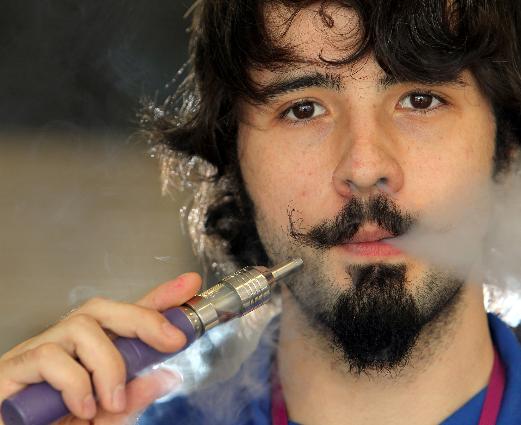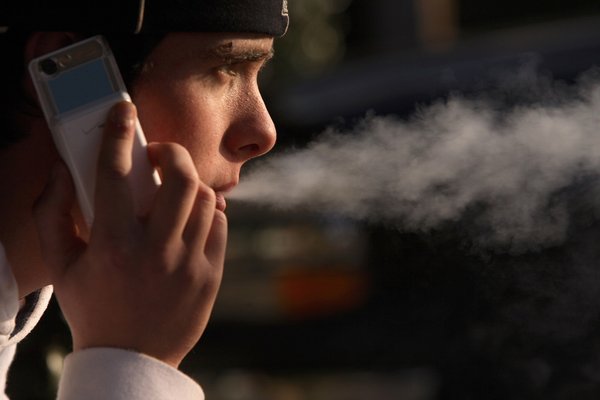Regulation push catching up with electronic cigarettes
By John Keilman and Mitch Smith, Chicago Tribune reporters
Jay Altman smoked cigarettes for 25 years before deciding a few months ago that for the sake of his wallet and his health, a change was in order.
But Altman didn’t quit — he switched.
The North Side insurance worker swapped his daily pack and a half of smokes for the vanilla-flavored nicotine aerosol of an electronic cigarette. He feels better these days, he said, and not just because he’s saving more than $100 a week.
“My friends have noticed a difference,” Altman said while sampling assorted flavors at Smoque Vapours, an e-cigarette shop in the Loop. “They’ll say, ‘You smell good,’ instead of, ‘You stink.'”
The fast-growing e-cigarette industry has hitched its future to such testimonials, pitching its product as a safer and cheaper alternative to tobacco cigarettes. So far the business has escaped the reach of regulators, but from Washington, D.C., to the Chicago suburbs, that is changing quickly.
The U.S. Food and Drug Administration appears poised to label e-cigarettes a “tobacco product,” a distinction that would give the agency power over their marketing, manufacture and sale. North suburban Mundelein just passed an ordinance banning the sale of e-cigarettes to anyone younger than 18, and on Jan. 1 a similar law will take effect statewide.
Evanston, meanwhile, has gone even further, banning the use of e-cigarettes anywhere smoking is prohibited.
“There hasn’t been a whole lot of long-term research on this, but we really wanted to make sure we were on the front end to protect our residents,” said Carl Caneva, assistant director of Evanston’s health department.
The lack of regulation has turned e-cigarettes into a commercial Wild West, where basement chemists and giant corporations alike concoct mixtures that taste like everything from peach schnapps to Mountain Dew. The novel flavors concern anti-smoking advocates, who note that teen e-cigarette use recently doubled within a single year.
“I don’t think that there’s any question that flavors appeal to young people,” said Danny McGoldrick of the Campaign for Tobacco-Free Kids. “It’s just another way to help introduce them to the habit.”
Researchers aren’t sure of all the chemicals released by the products, but some say there’s ample reason for worry.
The American Lung Association, which favors strict regulation, cites a recent study that found chemicals such as formaldehyde and acetone in exhaled e-cigarette vapor.
“We’re very concerned because we don’t know what’s in e-cigarettes or what the health consequences of them might be,” said Erika Sward, the lung association’s assistant vice president for national advocacy. “Frankly, until the FDA begins its oversight of these products, I think everyone needs to proceed very cautiously.”
E-cigarettes use tiny atomizers to turn nicotine-infused liquids into an aerosol, which is inhaled by the user. They’ve been sold in the United States since the mid-2000s, but the Electronic Cigarette Industry Group says sales have boomed in recent years, turning the gadgets into a $2 billion-a-year business.
The group’s president, Eric Criss, said e-cigarettes are intended to be a safer alternative for people who already smoke.
“We feel very strongly that we not be taxed and regulated as a tobacco product because our goal as an industry is to distinguish ourselves from traditional tobacco cigarettes,” he said. “We believe there’s a ladder of harm. Cigarettes are at the top of that, and our goal is to get people to move down that ladder.”
The science behind that claim is far from settled. The industry points to research — some of it funded by e-cigarette interests — that shows the products to be less risky to users, sometimes called “vapers,” and bystanders alike. Robert West, a health psychology professor at University College London, maintains that a global switch from tobacco cigarettes to atomized nicotine would save millions of lives a year.
Stanton Glantz, director of the Center for Tobacco Control Research & Education at the University of California at San Francisco, agreed that e-cigarettes appear to be less harmful than tobacco but said they’re hardly risk-free.
He said most smokers don’t give up tobacco cigarettes entirely when they use electronic ones, so their health doesn’t improve much. And while bystanders aren’t exposed to secondhand smoke, he said, initial research shows that they’re still inhaling nicotine, an addictive substance, along with toxic chemicals and ultrafine particles that can cause heart problems.
“Just because someone chooses to service their (nicotine) addiction by using an e-cigarette, that still doesn’t create a right for them to poison people in the neighborhood,” Glantz said.
The FDA says a federal appeals court has given it the power to regulate e-cigarettes as though they are tobacco products. The agency has a proposed regulation in the works, and while officials won’t say what it contains, public health advocates and industry representatives expect the FDA to assert its authority over e-cigarettes.
Many states are waiting for that to happen before deciding whether to incorporate e-cigarettes into smoking bans, but Glantz argues that new rules could take years to finalize and aren’t necessary for states to tighten their clean air laws.
Three states — North Dakota, New Jersey and Utah — already include e-cigarettes in their smoking bans, and about 100 cities and counties nationwide have taken similar steps, according to the American Nonsmokers’ Rights Foundation.
But Melaney Arnold, spokeswoman for the Illinois Department of Public Health, said the research on e-cigarettes’ secondhand effects is still too preliminary to act upon.
“It’s still evolving, and it will still (take) time until we know the total health effects,” she said.
Chicago Ald. Edward Burke, who often takes up health issues, has a proposed ordinance before the City Council to ban the sale of e-cigarettes to minors. He said he might try to amend it to make e-cigarettes subject to the city’s smoking ban.
“I think we certainly should apply the same regulations to e-cigarettes that we apply to regular cigarettes,” the 14th Ward alderman said.
For now, though, the devices exist in a mishmash of vague and confusing regulations. They’re not allowed to be used on airplanes, though the U.S. Department of Transportation doesn’t explicitly ban them. They’re not allowed in Chicago’s airports, though city ordinances are silent on the point.
“As a practical matter, airport staff does not determine if a cigarette that is being smoked is a tobacco cigarette or an e-cigarette,” said Karen Pride, spokeswoman for the Chicago Department of Aviation. “As such, the use of electronic cigarettes, as with tobacco cigarettes, is prohibited in the airports.”
While the city allows bar patrons to partake of e-cigarettes, taverns make their own rules. Declan’s Irish Pub in Old Town and Lange’s Lounge in Lakeview have no problems with the devices, but Joe’s Bar, a Goose Island establishment, says no.
“We don’t allow it inside because it promotes other people to take out their cigarettes and smoke them,” general manager Bob Casey said.
Despite the lack of clarity over e-cigarette use, several boutique shops selling the devices have sprung up in the city. Jared Yucht, owner of Smoque Vapours, said he started creating “e-liquids” in his basement when he stopped smoking. He opened his first store and lounge in Lakeview last spring and added a second location in the Loop this month.
He said he is proud of his safety precautions, carefully monitoring the nicotine levels of his products and refusing to sell to minors, though neither step is yet required by law.
“I don’t know anyone who owns another store who serves underage,” he said. “I have children and I wouldn’t want them taking stimulants at a young age. It’s an unwritten rule in the community that this is an adult activity for adults.”
http://www.chicagotribune.com/news/local/ct-met-electronic-cigarettes-20131115,0,5010760.story?page=1



